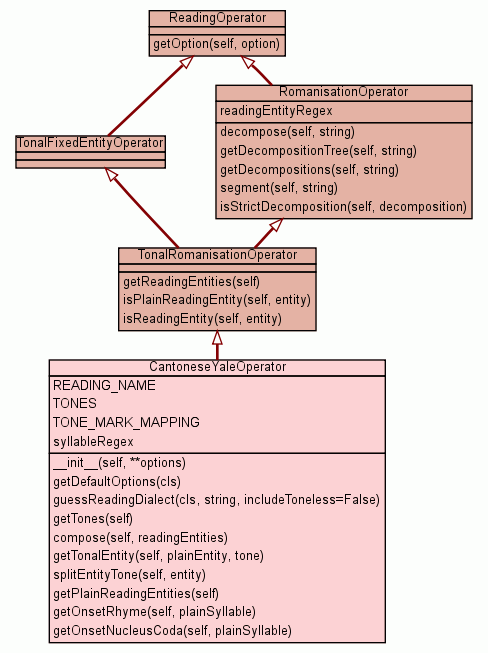
| Home | Trees | Indices | Help |
|
|---|
|
|

Provides an operator for the Cantonese Yale romanisation.
Features:
Yale distinguishes two tones often subsumed under one: the high level tone with tone contour 55 as given in the commonly used pitch model by Yuen Ren Chao and the high falling tone given as pitch 53 (as by Chao), 52 or 51 (Bauer and Benedikt, chapter 2.1.1 pp. 115). Many sources state that these two tones aren't distinguishable anymore in modern Hong Kong Cantonese and thus are subsumed under one tone in some romanisation systems for Cantonese.
In the abbreviated form of the Yale romanisation that uses numbers
to represent tones this distinction is not made. The mapping of the
tone number 1 to either the high level or the high falling
tone can be given by the user and is important when conversion is done
involving this abbreviated form of the Yale romanisation. By default
the the high level tone will be used as this primary use is indicated
in the given sources.
See Also:
|
|||
|
|||
| list |
|
||
| str |
|
||
| str |
|
||
| tuple |
|
||
| set of str |
|
||
| tuple of str |
|
||
| tuple of str |
|
||
|
Inherited from Inherited from Inherited from Inherited from Inherited from |
|||
|
|||
| dict |
|
||
| dict |
|
||
|
|||
| list of str |
|
||
|
Inherited from |
|||
|
|||
READING_NAME = Unique name of reading |
|||
TONES = Names of tones used in the romanisation. |
|||
TONE_MARK_MAPPING = Mapping of tone name to representation per tone mark type. |
|||
syllableRegex = re.compile(r'Regex to split a string in NFD into several syllables in a crude way. |
|||
|
Inherited from |
|||
|
|||
|
Inherited from |
|||
|
|||
Creates an instance of the CantoneseYaleOperator.
|
Returns the reading operator's default options. The default implementation returns an empty dictionary. The keyword 'dbConnectInst' is not regarded a configuration option of the operator and is thus not included in the dict returned.
|
Gets a list of Cantonese Yale vowels with diacritical marks for tones. The list includes characters m, n and h for nasal forms.
|
Takes a string written in Cantonese Yale and guesses the reading dialect. Currently only the option
|
Returns a set of tones supported by the reading. These tones don't necessarily reflect the tones of the underlying language but may defer to reflect notational or other features. The default implementation will raise a NotImplementedError.
|
Composes the given list of basic entities to a string. The default implementation will raise a NotImplementedError.
|
Gets the entity with tone mark for the given plain entity and tone. The default implementation will raise a NotImplementedError.
To Do (Lang): Place the tone mark on the first character of the nucleus? |
Splits the entity into an entity without tone mark and the entity's tone index. The plain entity returned will always be in Unicode's Normalization Form C (NFC, see http://www.unicode.org/reports/tr15/).
|
Gets the list of plain entities supported by this reading. Different to getReadingEntities() the entities will carry no tone mark. The default implementation will raise a NotImplementedError.
|
Splits the given plain syllable into onset (initial) and rhyme (final). The syllabic nasals m, ng will be returned as final. Syllables yu, yun, yut will fall into (y, yu, ), (y, yu, n) and (y, yu, t).
|
Splits the given plain syllable into onset (initial), nucleus and coda, the latter building the rhyme (final). The syllabic nasals m, ng will be returned as coda. Syllables yu, yun, yut will fall into (y, yu, ), (y, yu, n) and (y, yu, t).
To Do (Impl): Finals ing, ik, ung, uk, eun, eut, a differ from other finals with same vowels. What semantics/view do we want to provide on the syllable parts? |
|
|||
TONESNames of tones used in the romanisation.
|
TONE_MARK_MAPPINGMapping of tone name to representation per tone mark type. Representations includes a diacritic mark and optional the letter 'h' marking a low tone. The
|
syllableRegexRegex to split a string in NFD into several syllables in a crude way. The regular expressions works for both, diacritical and number tone marks. It consists of:
|
| Home | Trees | Indices | Help |
|
|---|
| Generated by Epydoc 3.0.1 on Tue May 19 22:38:37 2009 | http://epydoc.sourceforge.net |